The Spatiotemporal Distribution Law of Microseismic Events and Rockburst Characteristics of the Deeply Buried Tunnel Group
Abstract
:1. Introduction
2. Project Overview and Geological Conditions
3. MS Monitoring Scheme
3.1. Method of MS Source Hierarchical Location
3.2. Monitoring System
3.3. Installation and Arrangement of Sensors
3.3.1. The Installation Requirements of Sensors
3.3.2. The Arrangement of Sensors
3.3.3. The Connection of the Main Equipment
3.4. MS Signal Processing
3.5. Identification of Rockburst
4. MS Monitoring Results
4.1. Time Distribution Law of MS Events
4.2. Spatial Distribution of MS Events
5. Analysis of Rockburst Characteristics
5.1. Stratum Characteristic
5.2. Size Effect of Excavation Section
5.2.1. Rockburst in Auxiliary Tunnels
5.2.2. Rockburst in the Drainage Tunnel
5.2.3. Rockburst in the Cross Passage of the Diversion Tunnels
5.2.4. Rockburst in the Diversion Tunnels
6. Numerical Simulation
6.1. Model Description
6.2. Simulation Results and Discussion
7. Conclusions
Author Contributions
Funding
Acknowledgments
Conflicts of Interest
References
- Kaiser, P.K.; Cai, M. Design of rock support system under rockburst condition. J. Rock Mech. Geotech. Eng. 2012, 4, 215–227. [Google Scholar] [CrossRef]
- Feng, X.T.; Yang, Y.; Feng, G.L.; Xiao, Y.X.; Chen, B.R.; Jiang, Q. Fractal behaviour of the microseismic energy associated with immediate rockbursts in deep, hard rock tunnels. Tunn. Undergr. Space Technol. 2016, 51, 98–107. [Google Scholar] [CrossRef]
- Zhang, Z.Q.; Zhang, H.; Tan, Y.J.; Yang, H.Y. Natural wind utilization in the vertical shaft of a super-long highway tunnel and its energy saving effect. Build. Environ. 2018, 145, 140–152. [Google Scholar] [CrossRef]
- Zhang, Z.Q.; Shi, X.Q.; Wang, B.; Li, H.Y. Stability of NATM tunnel faces in soft surrounding rocks. Comput. Geotech. 2018, 96, 90–102. [Google Scholar] [CrossRef]
- Hudyma, M.; Potvin, Y.H. An engineering approach to seismic risk management in hardrock mines. Rock Mech. Rock Eng. 2010, 43, 891–906. [Google Scholar] [CrossRef]
- Beck, D.A.; Brady, B.H.G. Evaluation and application of controlling parameters for seismic events in hard-rock mines. Int. J. Rock Mech. Min. Sci. 2002, 39, 633–642. [Google Scholar] [CrossRef]
- Li, T.B.; Ma, C.C; Zhu, M.L.; Meng, L.B.; Chen, G.Q. Geomechanical types and mechanical analyses of rockbursts. Eng. Geol. 2017, 222, 72–83. [Google Scholar]
- Hatzor, Y.H.; He, B.G.; Feng, X.T. Scaling rockburst hazard using the DDA and GSI methods. Tunn. Undergr. Space Technol. 2017, 70, 343–362. [Google Scholar] [CrossRef]
- Chen, B.R.; Feng, X.T.; Li, Q.P.; Luo, R.Z.; Li, S.J. Rock burst intensity classification based on the radiated energy with damage intensity at Jinping II hydropower station, China. Rock Mech. Rock Eng. 2015, 48, 289–303. [Google Scholar] [CrossRef]
- He, M.C.; Sousa, L.R.; Miranda, T.; Zhu, G.L. Rockburst laboratory tests database- Application of data mining techniques. Eng. Geol. 2015, 185, 116–130. [Google Scholar] [CrossRef]
- Cai, M.; Kaiser, P.K.; Martin, C.D. Quantification of rock mass damage in underground excavations from microseismic event monitoring. Int. J. Rock Mech. Min. Sci. 2001, 38, 1135–1145. [Google Scholar] [CrossRef]
- Naji, A.M.; Rehman, H.; Emad, M.Z.; Yoo, H. Impact of Shear Zone on Rockburst in the Deep Neelum-Jehlum Hydropower Tunnel: A Numerical Modeling Approach. Energies 2018, 11, 1935. [Google Scholar] [CrossRef]
- Xue, Y.; Cao, Z.; Du, F.; Zhu, L. The influence of the backfilling roadway driving sequence on the rockburst risk of a coal pillar based on an energy density criterion. Sustainability 2018, 10, 2609. [Google Scholar] [CrossRef]
- Wang, Z.Y.; Dou, L.M.; Wang, G.F. Mechanism analysis of roadway rockbursts induced by dynamic mining loading and its application. Energies 2018, 11, 2313. [Google Scholar] [CrossRef]
- Ma, K.; Tang, C.A.; Wang, L.X.; Tang, D.H.; Zhuang, D.Y.; Zhang, Q.B.; Zhao, J. Stability analysis of underground oil storage caverns by an integrated numerical and microseismic monitoring approach. Tunn. Undergr. Space Technol. 2016, 54, 81–91. [Google Scholar] [CrossRef] [Green Version]
- Xie, H.; Pariseau, W.G. Fractal character and mechanism of rock bursts. Int. J. Rock Mech. Min. Sci. 1993, 30, 343–350. [Google Scholar] [CrossRef]
- Gong, Q.M.; Yin, L.J.; Wu, S.Y.; Zhao, J.; Ting, Y. Rock burst and slabbing failure and its influence on TBM excavation at headrace tunnels in Jinping II hydropower station. Eng. Geol. 2012, 124, 98–108. [Google Scholar] [CrossRef]
- Urbancic, T.I.; Trifu, C.I. Recent advances in seismic monitoring technology at Canadian mines. J. Appl. Geophy. 2000, 45, 225–237. [Google Scholar] [CrossRef]
- Durrheim, R.J.; Haile, A.; Roberts, M.K.C.; Schweitzer, J.K.; Spottiswoode, S.M.; Klokow, J.W. Violent failure of a remnant in a deep South African gold mine. Tectonophysics 1998, 289, 105–116. [Google Scholar] [CrossRef]
- Milev, A.M.; Spottiswoode, S.M.; Rorke, A.J.; Finnie, G.J. Seismic monitoring of a simulated rockburst on a wall of an underground tunnel. J. S. Afr. Inst. Min. Metall. 2001, 101, 253–260. [Google Scholar]
- Basson, F.R.P.; Van Der Merwe, S. Seismicity Management as Hill 50 Gold Mine, Western Australia. In Proceedings of the Fourth International Seminar on Deep and High Stress Mining, 7–9 November, Perth; Australian Centre for Geomechanics: Perth, Australia, 2007; pp. 233–242. [Google Scholar]
- Yang, C.X.; Luo, Z.Q.; Hu, G.B.; Liu, X.M. Application of a microseismic monitoring system in deep mining. J. Univ. Sci. Technol. B 2007, 14, 6–8. [Google Scholar] [CrossRef]
- Wang, J.M.; Zeng, X.H.; Zhou, J.F. Practices on rockburst prevention and control in headrace tunnels of Jinping II hydropower station. J. Rock Mech. Geotech Eng. 2012, 4, 258–268. [Google Scholar] [CrossRef]
- Wang, H.L.; Ge, M.C. Acoustic emission/microseismic source location analysis for a limestone mine exhibiting high horizontal stresses. Int. J. Rock Mech. Min. Sci. 2008, 45, 720–728. [Google Scholar] [CrossRef]
- Afraei, S.; Shahriar, K.; Madani, S.H. Developing intelligent classification models for rock burst prediction after recognizing significant predictor variables, Section 1: Literature review and data preprocessing procedure. Tunn. Undergr. Space Technol. 2019, 83, 324–353. [Google Scholar] [CrossRef]
- Cai, W.; Dou, Li.M.; Zhang, M.; Cao, W.Z.; Shi, J.Q.; Feng, L.F. A fuzzy comprehensive evaluation methodology for rock burst forecasting using microseismic monitoring. Tunn. Undergr. Space Technol. 2018, 80, 232–245. [Google Scholar] [CrossRef]
- Srinivasan, C.; Arora, S.K.; Benady, S. Precursory monitoring of impending rockbursts in Kolar gold mines from microseismic emissions at deeper levels. Int. J. Rock Mech. Min. Sci. 1999, 36, 941–948. [Google Scholar] [CrossRef]
- Xu, J.; Jiang, J.D.; Xu, N.; Liu, Q.S.; Gao, Y.F. A new energy index for evaluating the tendency of rockburst and its engineering application. Eng. Geol. 2017, 230, 46–54. [Google Scholar] [CrossRef]
- Li, S.J.; Feng, X.T.; Li, Z.H.; Chen, B.R.; Zhang, C.Q.; Zhou, H. In situ monitoring of rockburst nucleation and evolution in the deeply buried tunnels of Jinping II hydropower station. Eng. Geol. 2012, 137–138, 85–96. [Google Scholar] [CrossRef]
- Dai, F.; Li, B.; Xu, N.W.; Zhu, Y.G. Microseismic early warning of surrounding rock mass deformation in the underground powerhouse of the Houziyan hydropower station, China. Tunn. Undergr. Space Technol. 2017, 62, 64–74. [Google Scholar] [CrossRef]
- Dai, F.; Li, B.; Xu, N.W.; Fan, Y.L.; Zhang, C.Q. Deformation forecasting and stability analysis of large-scale underground powerhouse caverns from microseismic monitoring. Int. J. Rock Mech. Min. Sci. 2016, 86, 269–281. [Google Scholar] [CrossRef]
- Dai, F.; Jiang, P.; Xu, N.W.; Chen, W.F.; Tan, Y.S. Focal mechanism determination for microseismic events and its application to the left bank slope of the Baihetan hydropower station in China. Environ. Earth Sci. 2018, 77, 268. [Google Scholar] [CrossRef]
- Feng, G.L.; Feng, X.T.; Chen, B.R.; Xiao, Y.X. Microseismic sequences associated with rockbursts in the tunnels of the Jinping II hydropower station. Int. J. Rock Mech. Min. Sci. 2015, 80, 89–100. [Google Scholar] [CrossRef]
- Feng, G.L.; Feng, X.T.; Chen, B.R.; Xiao, Y.X. Performance and feasibility analysis of two microseismic location methods used in tunnel engineering. Tunn. Undergr. Space Technol. 2017, 63, 183–193. [Google Scholar] [CrossRef]
- Tang, C.A.; Wang, J.M.; Zhang, J.J. Preliminary engineering application of microseismic monitoring technique to rockburst prediction in tunneling of Jinping II project. Int. J. Rock Mech. Min. Sci. 2010, 2, 193–208. [Google Scholar] [CrossRef]
- Ma, T.H.; Tang, C.A.; Tang, L.X.; Zhang, W.D.; Wang, L. Rockburst characteristics and microseismic monitoring of deep-buried tunnels for Jinping II Hydropower Station. Tunn. Undergr. Space Technol. 2015, 49, 345–368. [Google Scholar] [CrossRef]
- Xu, N.W.; Li, T.B.; Dai, F.; Li, B.; Zhu, Y.G.; Yang, D.S. Microseismic monitoring and stability evaluation for the large scale underground caverns at the Houziyan hydropower station in Southwest China. Eng. Geol. 2015, 188, 48–67. [Google Scholar] [CrossRef]
- Zhang, J.S.; Lu, J.Y.; Jia, Y.R. Study of rockburst in the tunnel in Tianshengqiao II hydropower station. Water Power 1991, 10, 34–37. [Google Scholar]
- Zhou, D.P.; Hong, K.R. The rockburst features of Taipingyi tunnel and the prevention methods. Chin. J. Rock Mech. Eng. 1995, 14, 171–178. [Google Scholar]
- Xu, L.S.; Wang, L.S. Study of the laws of rockburst and its forecasting in the tunnel of Erlang mountain road. Chin. J. Geotech Eng. 1999, 21, 569–572. [Google Scholar]
- Gu, M.C.; He, F.L.; Chen, C.Z. Study of rockburst in Qinling tunnel. Chin. J. Rock Mech. Eng. 2002, 21, 1324–1329. [Google Scholar]
- Li, C.J.; Li, H.Q. Rockburst characteristics and treatment methods in Qinling tunnel. Tunn. Undergr. Works. 1999, 1, 36–41. [Google Scholar]
- Eberhart, R.C.; Kennedy, J. A new optimizer using particle swarm theory. In Proceedings of the Sixth International Symposium on Micro Machine and Human Science, Nagoya, Japan, 4–6 October 1995; IEEE: Piscataway, NJ, USA, 1995; pp. 39–43. [Google Scholar]
- Chen, B.R.; Feng, X.T.; Li, S.L.; Yuan, J.P.; Xu, S.C. Microseism source location with hierarchical strategy based on particle swarm optimization. Chin J. Rock Mech. Eng. 2009, 28, 741–749. [Google Scholar]
- Dong, L.J.; Li, X.B.; Tang, L.Z.; Gong, F.Q. Mathematical functions and parameters for microseismic source loction without pre-measuring speed. Chin J. Rock Mech. Eng. 2011, 30, 2057–2067. [Google Scholar]
- Kennedy, J.; Eberhart, R.C. Particle Swarm Optimization. In Proceedings of the 1995 IEEE International Conference on Neural Networks, Perth, Australia, 27 November–1 December 1995; IEEE: Piscataway, NJ, USA, 1995; pp. 1942–1948. [Google Scholar]
- Shi, Y.; Eberhart, R.C. Empirical study of particle swarm optimization. In Proceedings of the 1999 Congress on Evolutionary Computation, Washington, DC, USA, 6–9 July 1999; IEEE: Piscataway, NJ, USA, 1999; pp. 1945–1950. [Google Scholar]
- Li, L.J.; Huang, Z.B.; Liu, F.; Wu, Q.H. A heuristic particle swarm optimizer for optimization of pin connected structures. Comput Struct. 2007, 85, 340–349. [Google Scholar] [CrossRef]
- Seyedpoor, S.M.; Salajegheh, J.; Salajegheh, E.; Gholizadeh, S. Optimal design of arch dams subjected to earthquake loading by a combination of simultaneous perturbation stochastic approximation and particle swarm algorithms. Appl Soft Comput. 2011, 11, 39–48. [Google Scholar] [CrossRef]
- Eberhart, R.C.; Shi, Y. Tracking and optimizing dynamic systems with particle swarms. In Proceedings of the 2001 Congress on Evolutionary Computation, Seoul, Korea, 27–30 May 2001; IEEE: Piscataway, NJ, USA, 2001; pp. 94–100. [Google Scholar]
- Kidybinski, A.Q. Bursting liability indices of coal. Int. J. Rock Mech. Min. Sci. 1981, 18, 295–304. [Google Scholar] [CrossRef]
- Liu, N.; Zhang, C.S.; Chu, W.J.; Ni, S.H. Discussion on size effect of rock burst risk in deep buried tunnel. Chin J. Rock Mech. Eng. 2017, 36, 2514–2521. [Google Scholar]

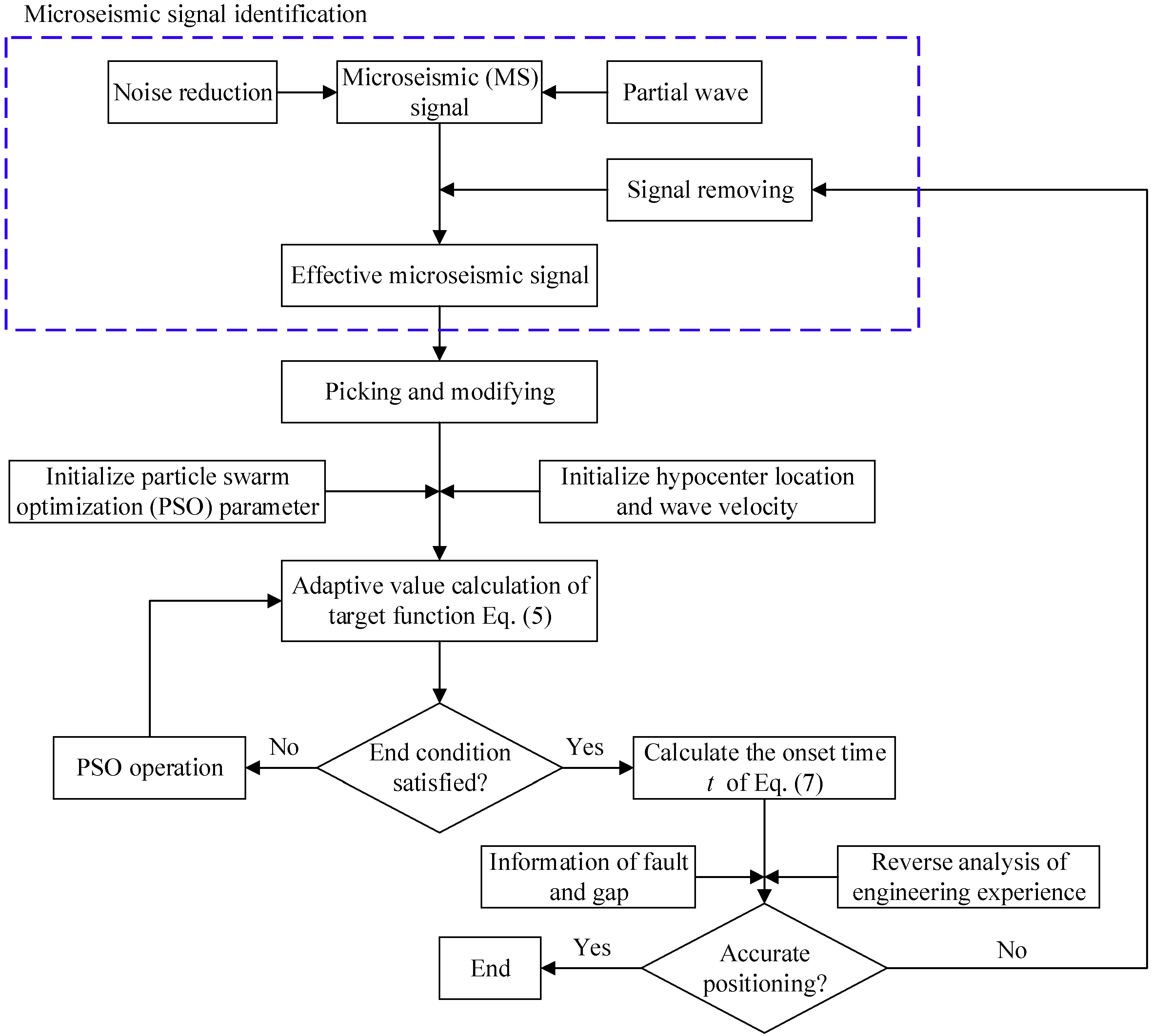

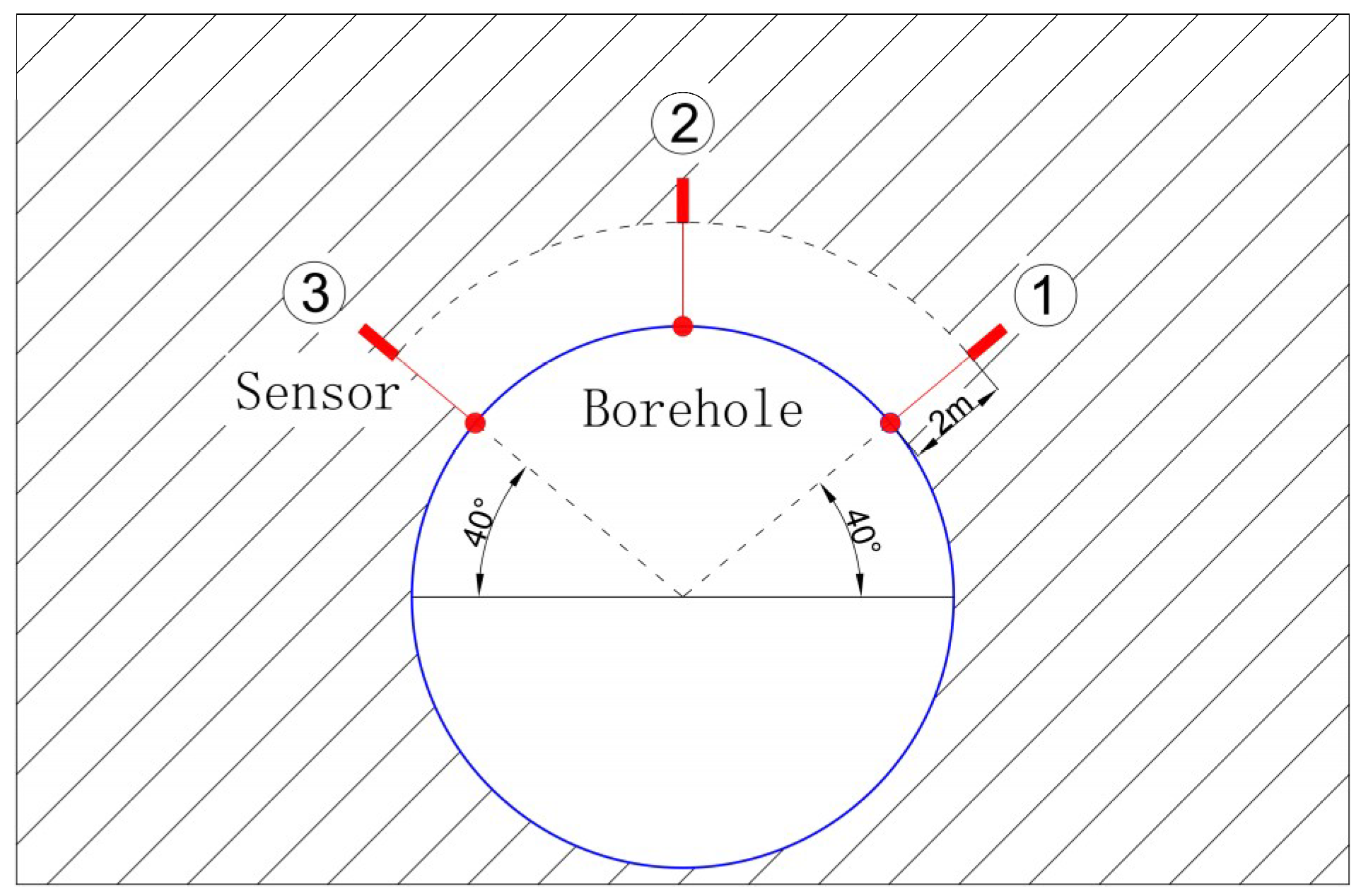

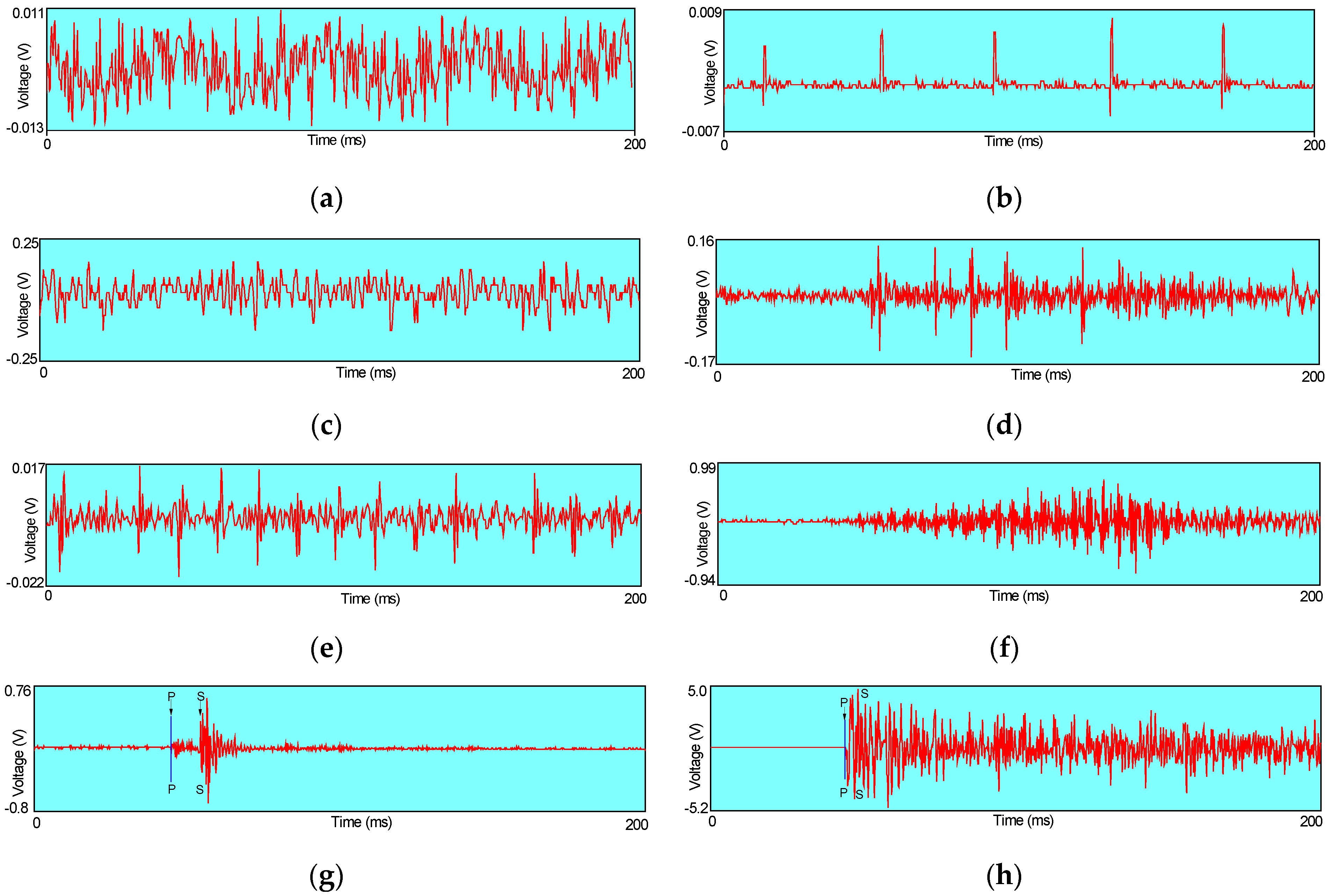
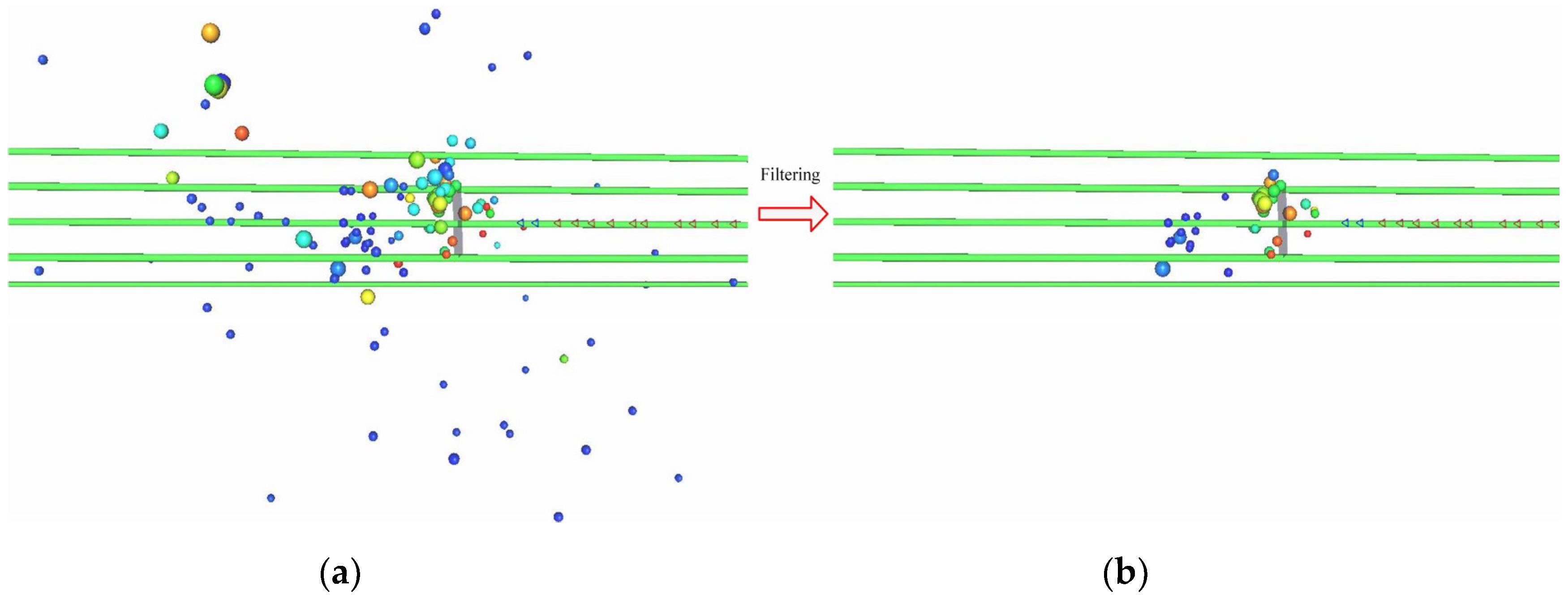
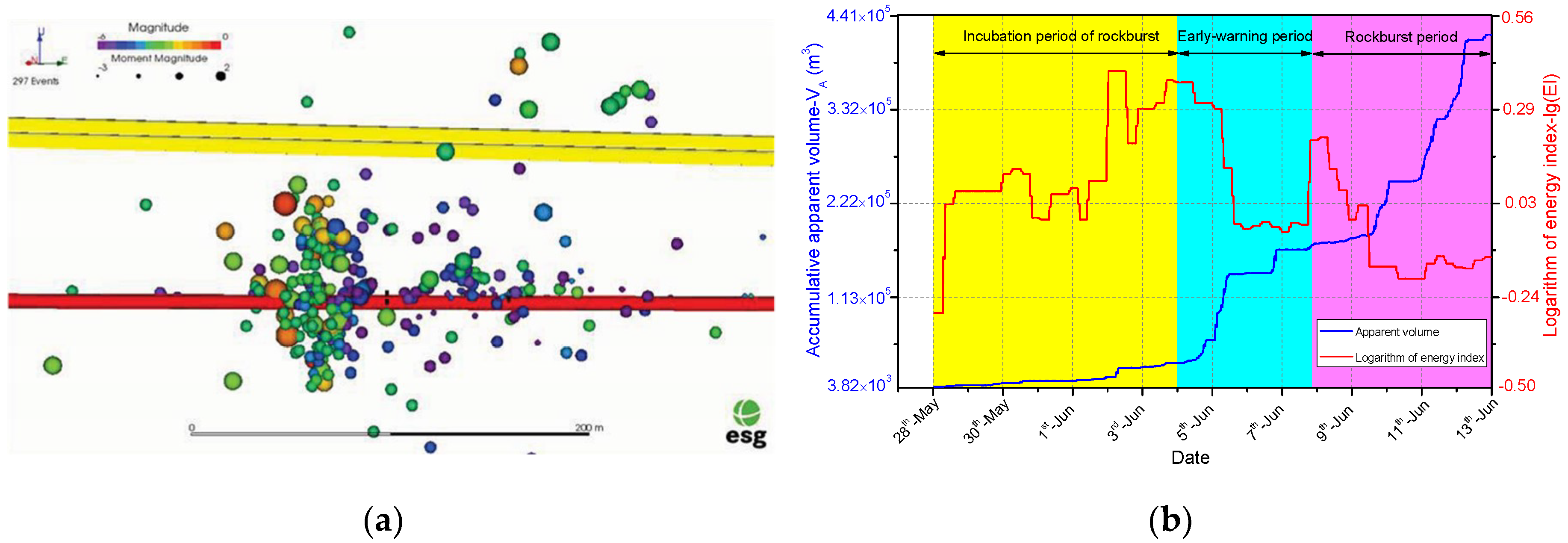
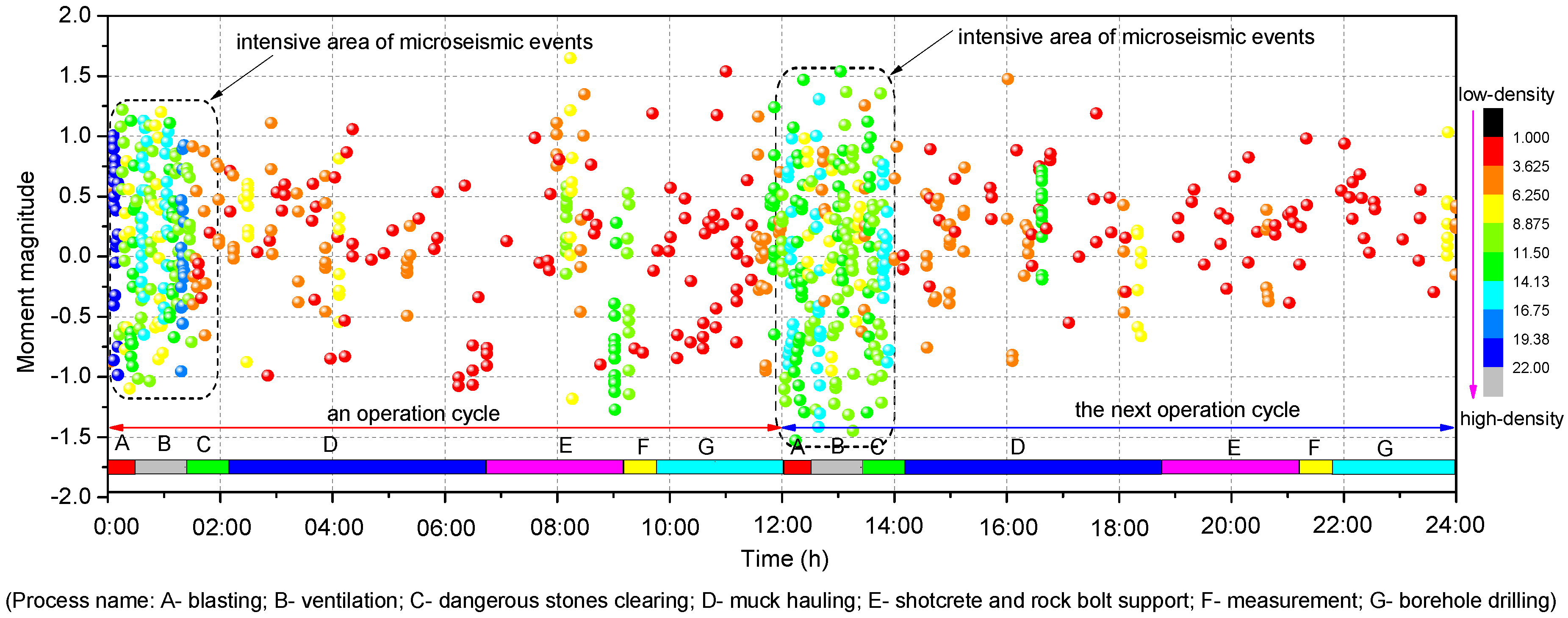
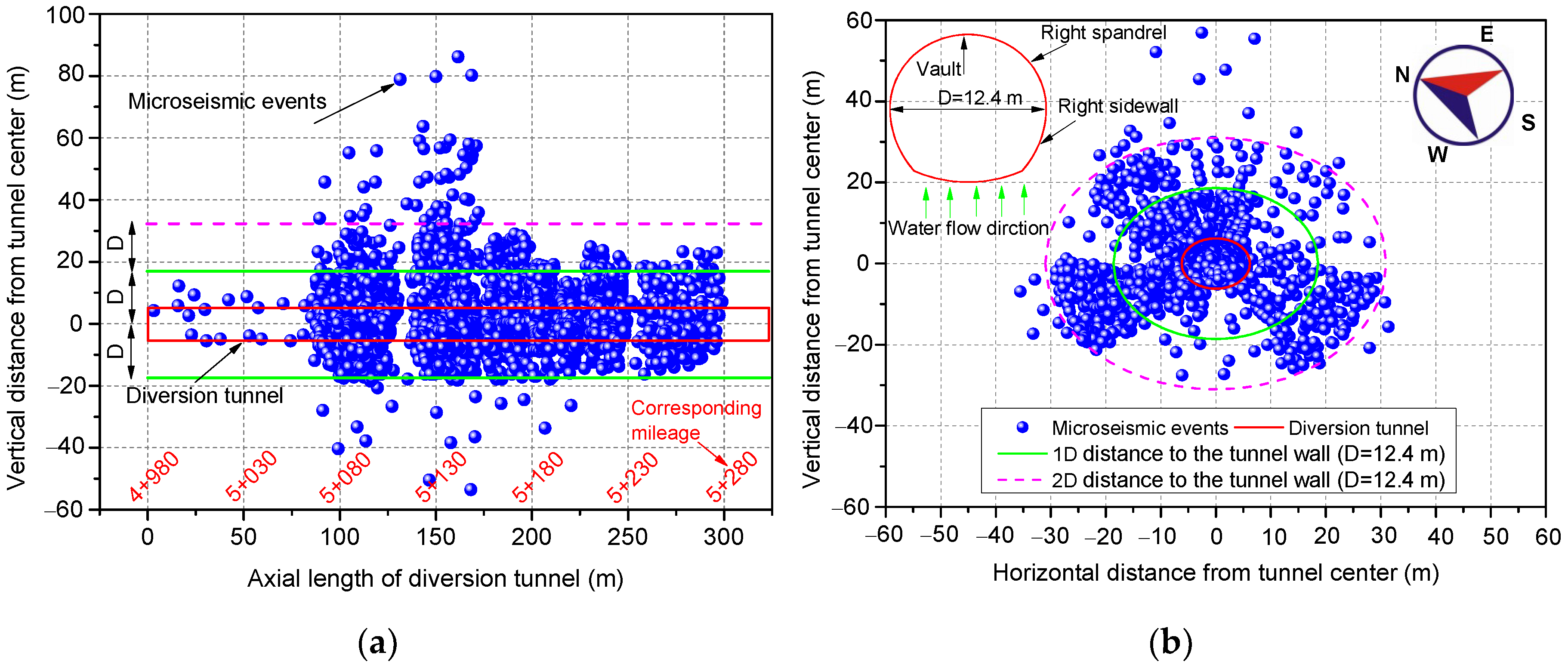


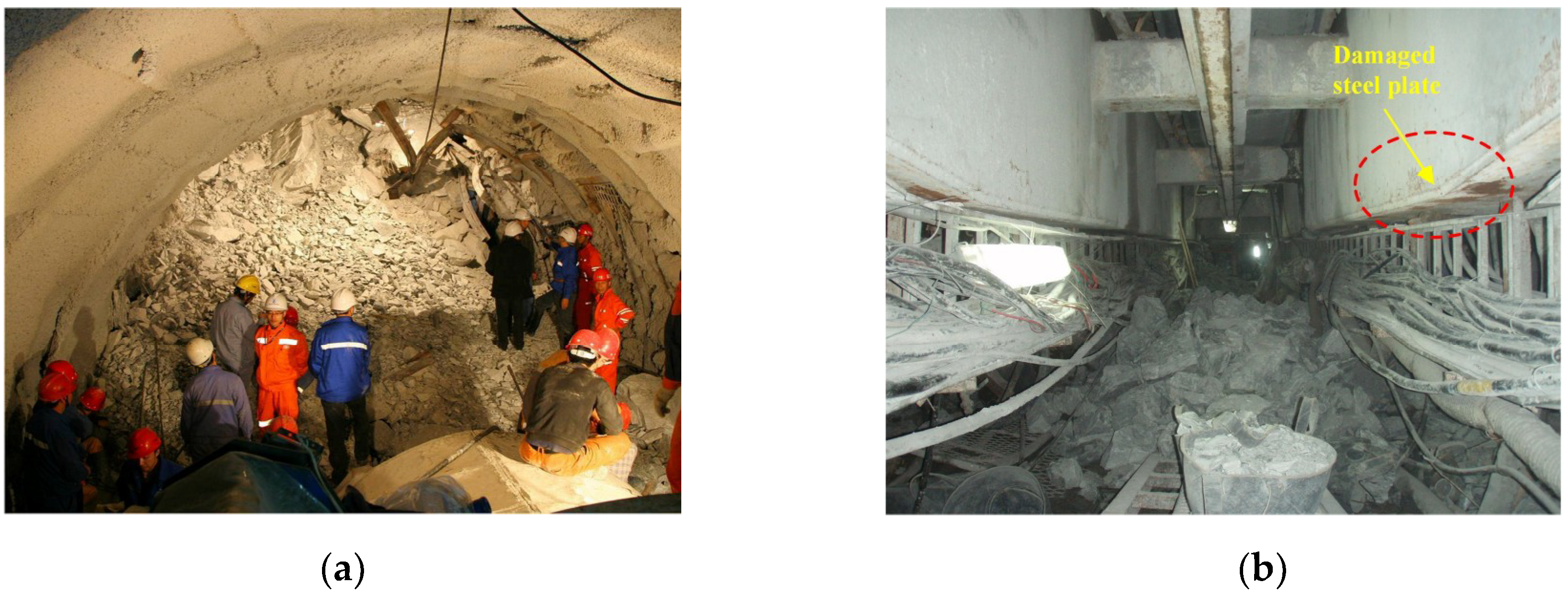

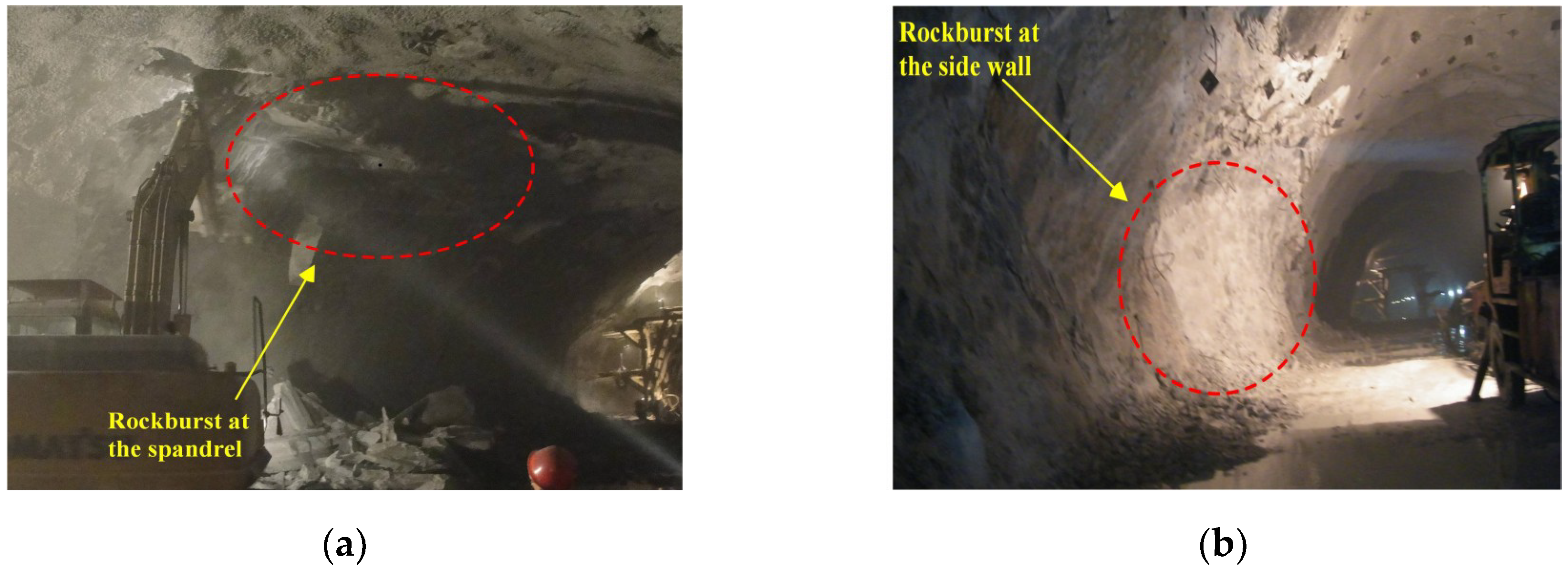

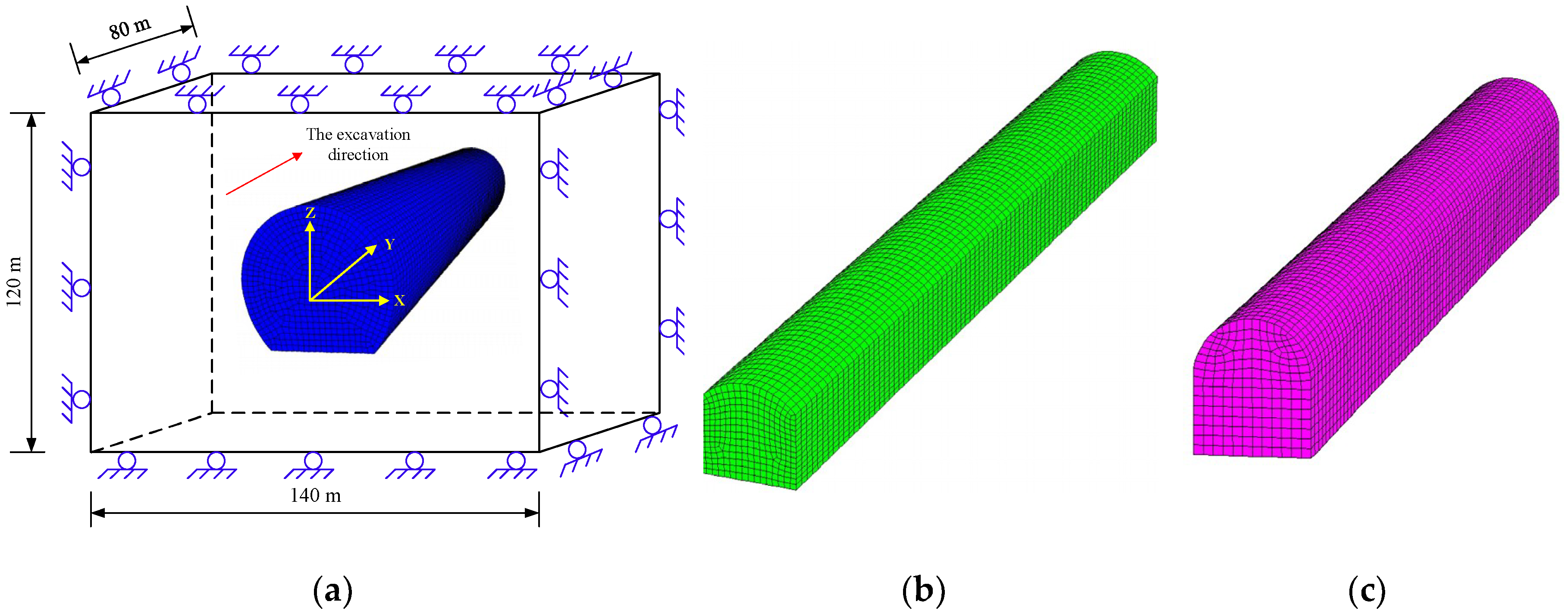

| Statistical Item | Length of Each Stratum Lithology (m) | Total (m) | Percentage (%) | |||||||
|---|---|---|---|---|---|---|---|---|---|---|
| T2y4 | T2y5 | T2y6 | T1 | T2z | T2b | T3 | Accounting for Total Length of Rockburst | Accounting for Total Excavation Length | ||
| Grade I rockburst | 23 | 1039.2 | 111 | 229 | 752 | 351 | 13 | 2518.2 | 81.20 | 8.04 |
| Grade II rockburst | 6 | 243.5 | 0 | 5 | 108 | 144 | 0 | 506.5 | 16.33 | 1.62 |
| Grade III rockburst | 14 | 0 | 0 | 0 | 0 | 51.4 | 0 | 65.4 | 2.11 | 0.21 |
| Grade IV rockburst | 0 | 0 | 0 | 0 | 0 | 11 | 0 | 11 | 0.35 | 0.04 |
| Rockburst in total (m) | 43 | 1282.7 | 111 | 234 | 860 | 557.4 | 13 | 3101.1 | 100 | 9.90 |
| Stratum length (m) | 1170 | 9942.9 | 5501.5 | 3110 | 8025.5 | 2654.5 | 816.5 | 31320.9 | / | / |
| Specimen Number | Rockburst Proneness Index Wet | Average Value | Rockburst Risk |
|---|---|---|---|
| 1 | 3.82 | 3.59 | Medium rockburst |
| 2 | 2.98 | ||
| 3 | 3.54 | ||
| 4 | 3.25 | ||
| 5 | 4.38 |
| Density ρ (kg/m3) | Poisson Ratio μ | Internal Friction Angle φ (°) | Cohesion C (MPa) | Elasticity Modulus E (GPa) |
|---|---|---|---|---|
| 2700 | 0.2 | 45 | 7.5 | 35 |
© 2018 by the authors. Licensee MDPI, Basel, Switzerland. This article is an open access article distributed under the terms and conditions of the Creative Commons Attribution (CC BY) license (http://creativecommons.org/licenses/by/4.0/).
Share and Cite
Zhang, H.; Chen, L.; Chen, S.; Sun, J.; Yang, J. The Spatiotemporal Distribution Law of Microseismic Events and Rockburst Characteristics of the Deeply Buried Tunnel Group. Energies 2018, 11, 3257. https://doi.org/10.3390/en11123257
Zhang H, Chen L, Chen S, Sun J, Yang J. The Spatiotemporal Distribution Law of Microseismic Events and Rockburst Characteristics of the Deeply Buried Tunnel Group. Energies. 2018; 11(12):3257. https://doi.org/10.3390/en11123257
Chicago/Turabian StyleZhang, Heng, Liang Chen, Shougen Chen, Jianchun Sun, and Jiasong Yang. 2018. "The Spatiotemporal Distribution Law of Microseismic Events and Rockburst Characteristics of the Deeply Buried Tunnel Group" Energies 11, no. 12: 3257. https://doi.org/10.3390/en11123257
APA StyleZhang, H., Chen, L., Chen, S., Sun, J., & Yang, J. (2018). The Spatiotemporal Distribution Law of Microseismic Events and Rockburst Characteristics of the Deeply Buried Tunnel Group. Energies, 11(12), 3257. https://doi.org/10.3390/en11123257





